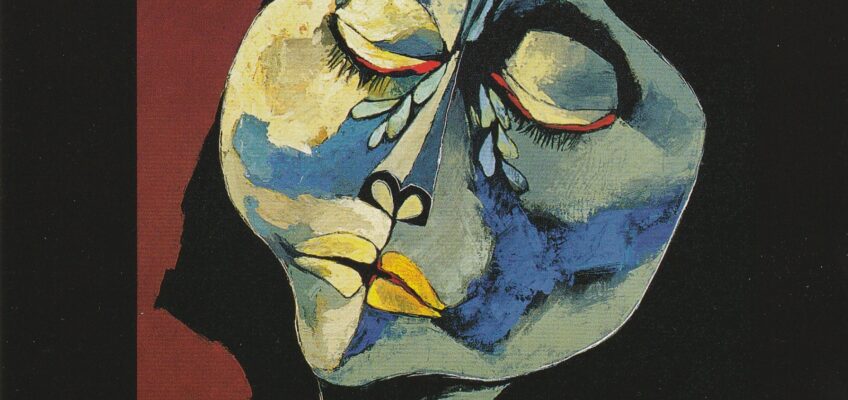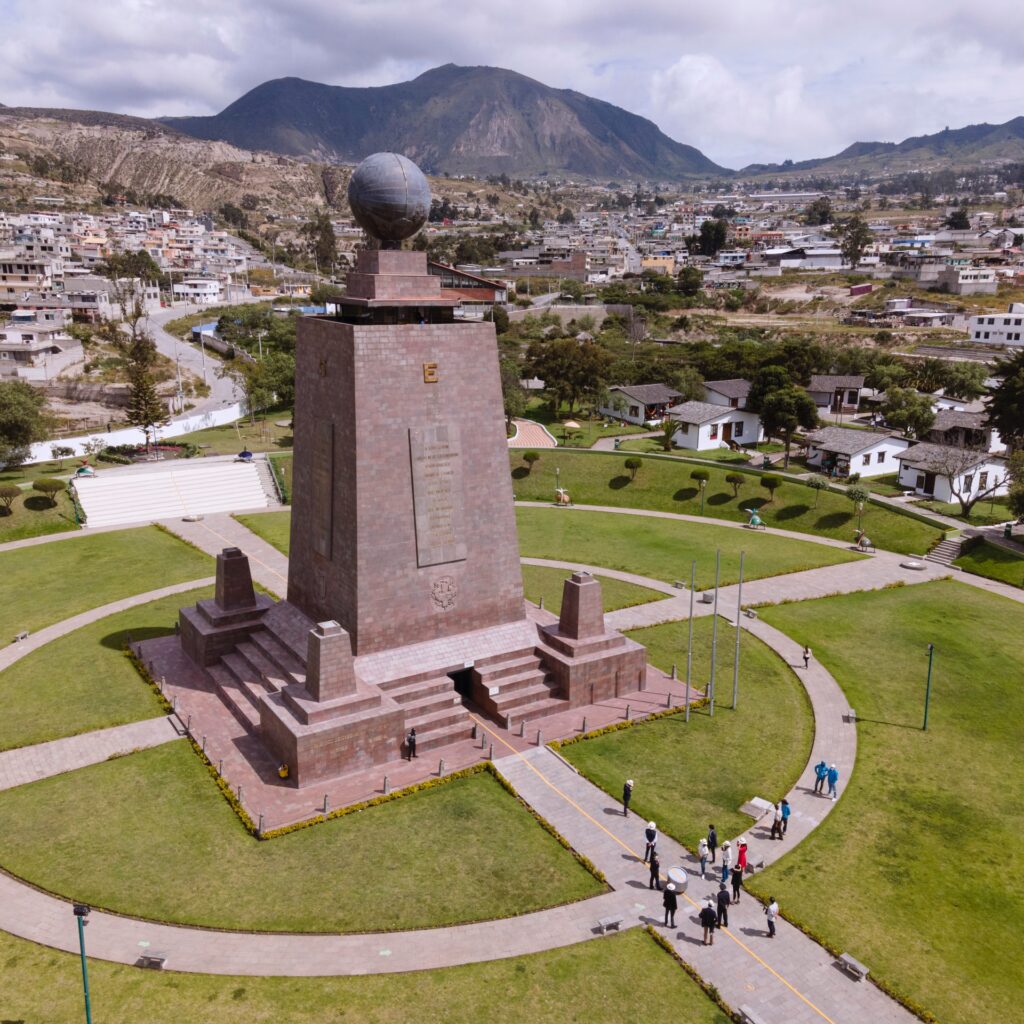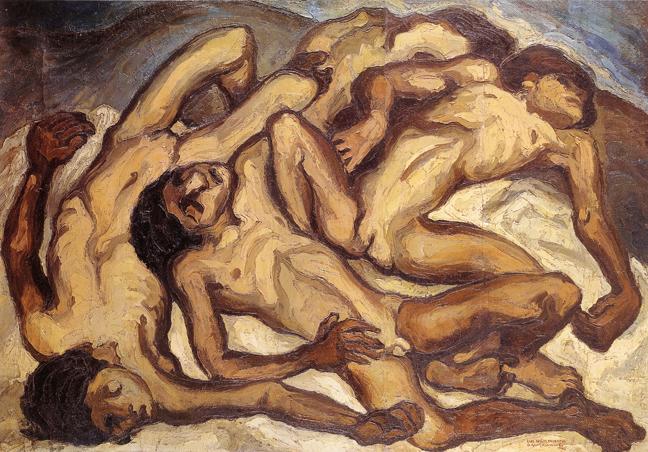When AeroMexico emailed me to tell me that my flight home from Quito was canceled and they rebooked me a day later, my first thought was annoyance. But then I realized I was getting an extra day in Quito, and that seemed more like a good thing.
And it was!
I should start off by mentioning that I got home yesterday, so this is a recap. And when I left off, I was rushed and unable to finish. So before I get to my extra day in Quito, here is…
Quito before Galápagos (continued)
Lunch with a view
After our walking tour of Quito’s historic center, we drove to a restaurant up in one of the hills overlooking the city. There we had a nice lunch.
Incidentally, Quito’s historic center was, along with Kraków, the first UNESCO World Heritage Site, so designated in 1978. We really saw why.
Visiting the equator
Quito is on the equator. Well, technically, it is at 0°13’47.46“S, or about 22/100 of a degree south of the equator. The actual equator is about 22 kilometers (14 miles) north of the city.
In 1736 a French expedition to what is now Ecuador determined the location of the equator. Ecuador is the best place in the world to find the equator, because it is the only country in the world where the equator does not pass through jungle or ocean.
In 1979 the Ecuadorian government erected a large monument at the site of the equator as determined by that French expedition.
We passed this monument on the way to the actual equator.
Yes, it turns out the 18th century astronomers on that French expedition were off by about 240 meters. The invention of GPS enabled a more precise calculation of the equator’s location.
At the actual equator is the Intiñan Solar Museum, and here’s the real place you can stand with one foot in the north and one foot in the south.
In addition to photo ops like this, we got a demo of how water goes down the drain north, south, and on the equator. And we got to try to balance an egg on the head of a nail (very difficult, even on the equator), to walk on the equator with our eyes closed and try to keep our balance (impossible) and to use our phone’s GPS to determine the accuracy (spot on).
Fundación Sinchi Sacha and the Mindalae Museum
In my rush to finish my previous post, I glossed over our visit to the Museo de Artesanías del Ecuador “Mindalae.” I really want to say more about this small but excellent museum.
The museum is run by the Fundación Sinchi Sacha. I translated the following from their Facebook page:
The Sinchi Sacha Foundation is a non-governmental institution that strategically contributes to the sustainable development of Ecuador.
It was created as a private, non-profit institution in 1991 by the Ministry of Social Inclusion of the Republic of Ecuador.
The Foundation has received recognition at the national level for its high degree of specialization in the promotion of ecotourism, artisanal fair trade, education and participatory planning, the restoration of natural and cultural heritage, as well as the generation of income for the low-income population.
Its mission includes the restoration of the natural and cultural heritage of Ecuador, the promotion of responsible tourism, craft production, education, local cultural revitalization, sustainable development, the proper use of natural resources, and the overcoming poverty.
We got to enjoy a private visit to the museum with a guided tour. The collection included ceramics, textiles and costumes, musical instruments, painting, baskets, woodwork, and so much more. Everything came with a story about the indigenous groups who created the work. Most of what we saw was not ancient, but current hand-crafted artistry using styles and techniques of ancestral peoples.
After our museum tour they served us an excellent lunch featuring many locally-sustainable ingredients, and we got to hear from the president of the Fundación Sinchi Sacha about their work. I truly came away feeling a deep connection with the history and culture of Ecuador.
La Ronda
That last evening I was all set to finish writing all you’ve been reading up to now. Celso, our trip leader, said we could meet in the lobby and head to a local spot in the neighborhood for a quick dinner. But when I got to the lobby, one of my fellow travelers convinced Celso that we should visit La Ronda. I said no, I’d stick with something in the neighborhood. But they convinced me to join them. The plan was to go, eat, and come right back.
We piled into two taxis. And then we sat in traffic for an hour.
Calle La Ronda is a cobbled street in the historic center and one of the oldest streets in Quito. Apparently it was abuzz with activity prior to Covid, filled with restaurants, nightspots, galleries, and shops. That night it was mostly quiet and empty. Restaurants had people on the street trying to entice us in.
Celso knew a place, and that’s where we went. The owner was delightful, and her college-age son came to chat with us and practice his English. The food was delicious!
It only took ten minutes to get back to the hotel after dinner. But my chance to finish blogging about Quito was gone. It was time for bed.
Return to Quito
I’m skipping the next four days. Sorry I’m taking things out of order. I’ll write separately about my experience in the Galápagos.
As I alluded to above, I originally booked a flight that would have taken me home the same night we got back from the Galápagos. But on April 2 I got an email from AeroMexico telling me my itinerary changed. I was now stuck for an extra day in Quito. At first I thought this was very annoying, but then I realized it was an opportunity to explore more of Quito. I booked an Airbnb close to where our hotel was, and I started reading up on things to see and do in Quito for a day.
Dinner
After I settled in at my Airbnb, the skies were threatening to open up, so I decided to chillax for a while. I watched the storm do its thing, and when the rain let up, I headed out for dinner.
The first night we were in Quito, Celso took a group of us out to an Ecuadorian restaurant. I decided I needed a night off, so I didn’t join the group. The next day they were all raving about it, so I got the name of the restaurant, Miskay. It turns out it was just four blocks from my Airbnb.
When I got there, right around 6pm, the place was practically empty. Just one other table of two was there. They were friendly and attentive. The brought me a complimentary tea and bread with a salsa. I ordered soup and a main dish, and the food was amazing.
Traditional soup made of three kind of potatoes, served with avocado cheese and paico’s oil
Pork tenderloin with a sauce made of milk, peanuts and bread, served with potatoes tortilla, muchines de yuca with honey, camote and cooked lettuce and tomato
After I finished, the server asked if I wanted dessert. I said yes, but let me rest and finish my glass of wine.
That was the last time any server came to my table.
It seems Miskay is very popular with tour groups. Celso wasn’t the only tour leader who liked to bring his groups there. By the time I was finishing my dinner, several large groups, tables of ten or twelve, arrived, and they kept the servers hopping. I tried multiple times to catch a server’s eye, but even when they noticed me, they never came back to my table.
Finally I got up, went to the front, asked for my check, paid, left a paltry tip, and that was that.
Parque Carolina and the Botanical Garden
The next morning I woke up early. The sun was shining, and I wanted to get out and enjoy the day, so I headed to Parque Carolina, a large park about a half-hour walk from where I was staying.
It was not even 8am when I got there. In the park is the Quito Botanical Garden, but it didn’t open until 10am, so I walked around the park for a while and then looked for somewhere to get breakfast. I enjoyed a very large omelet and went back to the park and sat on a bench for a while watching people until the Botanical Barden opened.
I spent almost two hours wandering around the Botanical Garden. My favorite part was the orchids, as you’ll see if you check out my photos.
Guayasamín
According to Google Maps it was about a 30-minute walk from Parque Carolina to the Casa Museo Guayasamín and Capilla del Hombre. Celso had recommended these museums, and it was not yet 11am, so I figured I’d take a walk.
Google Maps didn’t tell me that the walk was uphill all the way. At 9,400 feet of altitude, this was quite a hike.
But it was worth it.
The artist
I’d never heard of Oswaldo Guaysamín before, but I cannot fathom why.he is not better known outside his native Ecuador. Here’s a biographical sketch from Artnet:
Oswaldo Guayasamín was an Ecuadorian artist whose work is characterized by its Cubist-styled depictions of Latin American people. The artist focused especially on portraying the rampant oppression, poverty, and political strife he witnessed growing up in the region. Born on July 6, 1919 in Quito, Ecuador to parents of Quechua descent, Guayasamín showed a passion for art from an early age, and went on to attend the School of Fine Arts in Quito. The artist’s subsequent rise to prominence came about with his exhibition at the Salón Nacional de Acuarelistas y Dibujantes in 1948. Followed by shows at the São Paulo Biennial, the Luxembourg Palace in Paris, and the Palais de Glace in Buenos Aires. Guayasamín is considered by some to be a national hero. His legacy includes the completion of La Capilla del Hombre, a chapel remembering the mistreatment of indigenous peoples in Latin America. During his life, Guayasmín befriended the famed writers Gabriel Garcia-Marquez and Pablo Neruda. He once said “Mantengan encendida una luz que siempre voy a volver,” or “Keep a light burning for I will always return.”
artnet
Guayasamín died in 1999, before the completion of the Capilla del Hombre. Both his house, now a museum, and the adjacent Capilla sit in the Bella Vista neighborhood overlooking the city of Quito.
The art
Guaysamín described his work as belonging to three distinct periods: The Trail of Tears, the Age of Rage, and The Tenderness. The first two depict much of the suffering, poverty, and injustice perpetrated on indigenous peoples in Latin America and elsewhere. You can see the transition from sadness to intense anger. Then in the later works you can see his love for his mother and his homeland reflected in his work.
The painting in the photo at the top of this post, Niña llorando, dates from 1994 and illustrates the more tender side of his work. Check out more of his paintings from photos I took inside the house and the Capilla.
The rest of the day
I had high hopes for all the things I’d be able to do in Quito on my extra day. I wanted to go back to the historic center to see more of the beautiful architecture there. But after my encounter with Guayasamín, now past 2pm, I had to walk back down the long hill I’d walked up. And then I was hungry, so I went for lunch. And then I still had to walk back to my lodging.
Suddenly it was 4pm, and I was exhausted. The hammock on the balcony of my Airbnb was too enticing, so I settled in for a relaxing afternoon before I had to head to the airport for my flight home.
Quito, by the way, has a beautiful modern airport, one of the nicest I’ve ever flown through.
And it befits the beautiful city is serves.




Leave a Reply